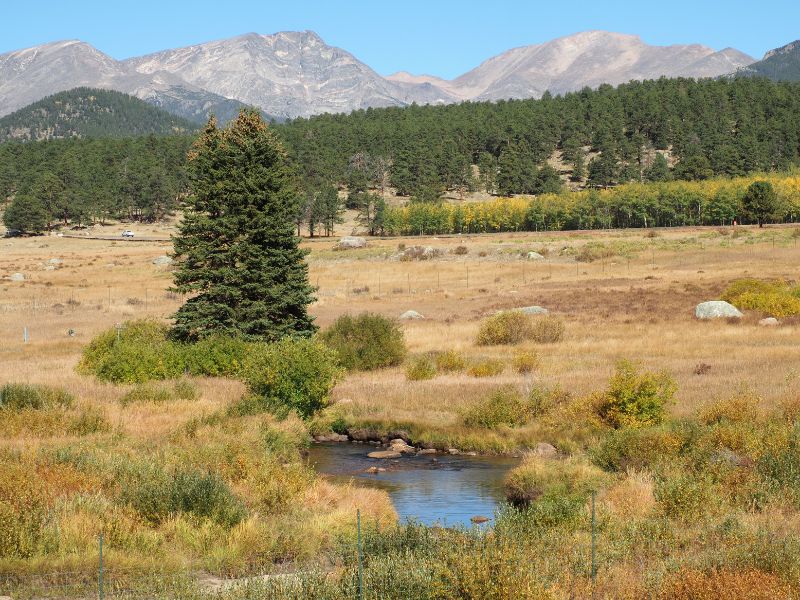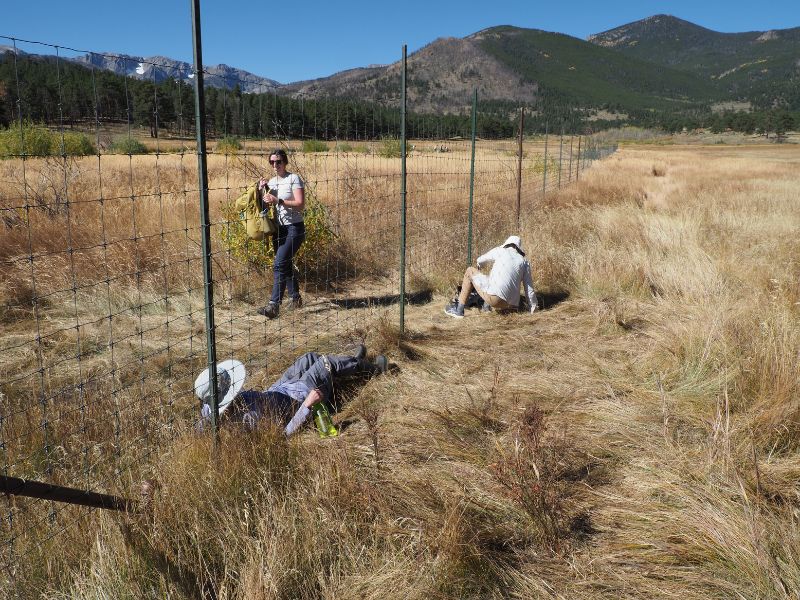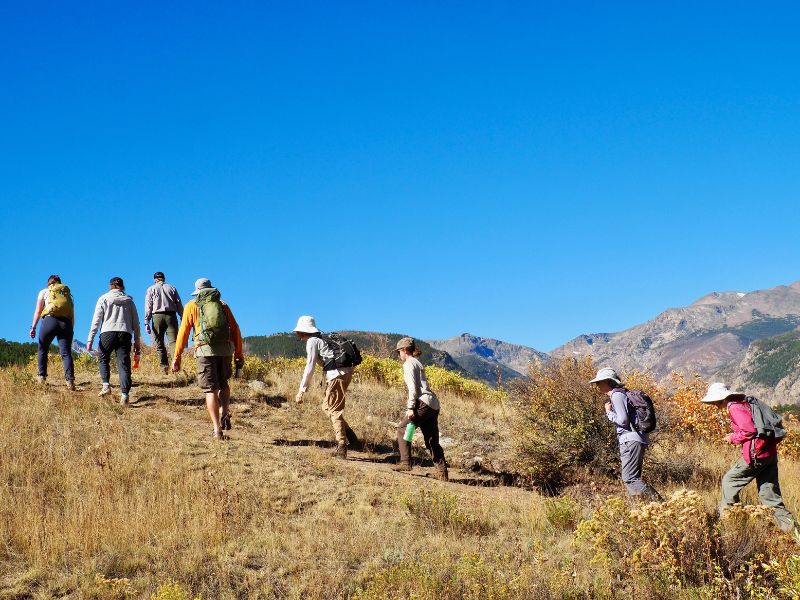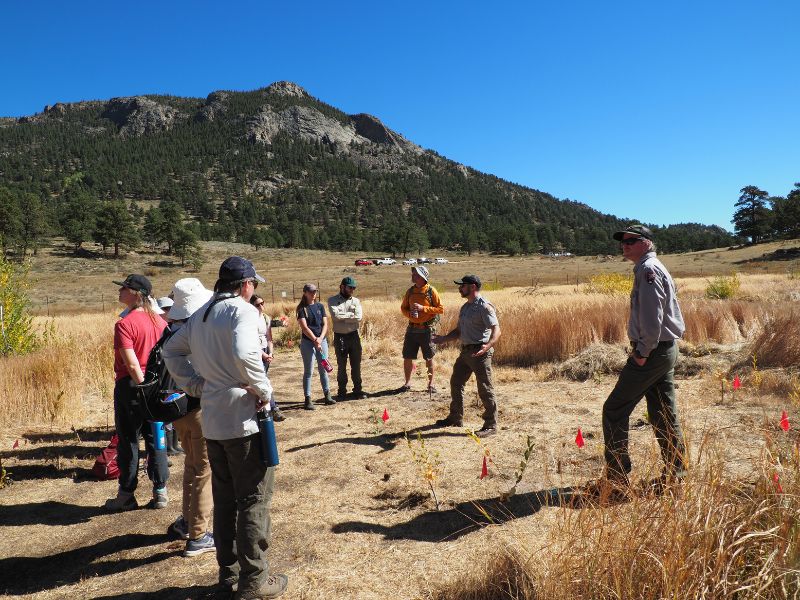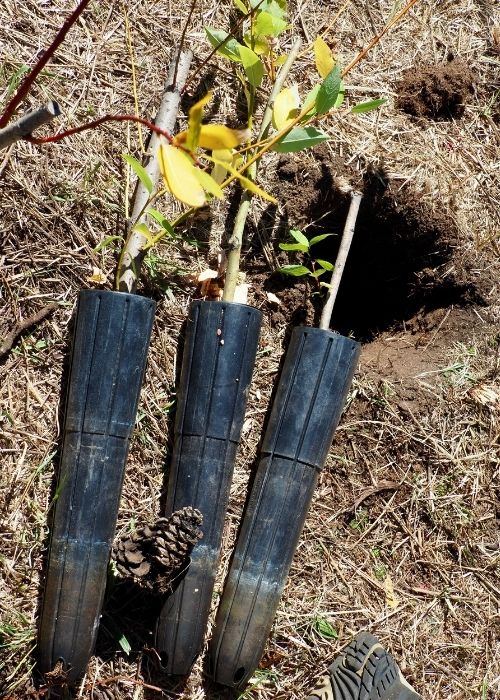It’s hard to overestimate the importance of wetlands in Colorado’s Rocky Mountains, where for millennia both humans and wildlife have been relying on them as a source of food, shelter, and clean water. In Rocky Mountain National Park, (RMNP) a concerted effort is underway to restore this precious resource which has been depleted by ever-increasing demands of growing cities, agricultural use, and even browsing by burgeoning numbers of elk and moose. The Boulder Chapter got to see restoration in progress recently, learning more about the vitality of wetlands and the challenges they face today. Our knowledgeable guides, Will Deacy,, Biologist, and Jim Bromberg, Restoration Ecologist, were a wealth of information and incredibly patient with our questions.
Beavers used to be key engineers in the wetlands at RMNP, helping
to keep water tables higher that they are today.
Wetlands in Rocky used to be beaver-willow ecosystems but as the hydrology changed, with lower water tables, and browsing became heavier than historically true, the wet meadows became more like an elk-grassland ecosystem. Moose, which are wetland specialists, also contributed to the decline. One of the interesting facts the chapter learned is that one moose equals 15 elk for the amount of vegetation consumed in a day. Moose are not actually native to Colorado, they used to wander through northern parts of the state from Wyoming, but were introduced into the state (north park area) in 1978 for hunting. We now have one of the fastest growing populations in the lower 48. Jim noted that it will be years before we know whether the reintroduction of wolves will keep the ungulate population in check, wolves so far don’t stay in the park to form resident packs because the elk move down in winter.
Native willow trees play a crucial role in our wetland systems. In addition to providing food for herbivores they also act as firebreaks, preventing the spread of wildfires. One of their most important functions for Coloradans is their role in maintaining clean water quality. Their extensive root systems help to stabilize stream banks, preventing erosion and sedimentation. They filter water and sediment by removing contaminants such as heavy metals, fertilizers, and pesticides. Willow flowers emerge early in spring, providing and essential food source for pollinators, contributing to the overall health and biodiversity of the ecosystem.
Restoration Ecologist, Jim Bromberg explains how willows are incubated in the RMNP nursery.
The Park at first used whole willow fronds, which root easily when just stuck into the soil in appropriate sites, but found that the supplies available within the park were depleted too quickly. Now they use a single thicker piece to propagate multiple new starts in their nursery. The Park’s nursery uses 18-inch deep cones to grow out their young plants, good roots are a critical element for successful young plants. To mimic natural conditions willow starts are kept with their feet in water during the entire incubation process.
Some people will do anything to see native plants! The Boulder chapter gets rolling.
The Boulder chapter visited one new planting site, taking advantage of the opportunity to ask lot of questions! Will and Jim explained that weed whips were used to beat back the non-native brome grass. The tender new plants are subject to herbivory from small mammals, so a ‘danger zone’ is set up between them and the brome monoculture, where small animals will be more visible to raptors and unlikely to take the risk of traversing it. Although the grass will regenerate in spring, the new trees will be high enough to hold their own and get the sunlight they need to thrive. These plantings will have the benefit of being watered in for a short time, and be ready to take off come spring.
The Boulder chapter’s field trip treks upward to see one of the new areas under restoration at RMNP.
Our RMNP guides explain how weed whips clear an area for planting. Red flags mark the new trees.
Planting is happy work! The Park pulled staff from many different departements to help get trees in the ground.
Use of deep cones gives plant roots a strong start, these are 18 inches deep. Note the use of pine cones to plug cone bottoms.
In many areas of the Intermountain West, more than 80% of wildlife species depend on wetland and riparian areas at some point in their lives. In arid climates like Colorado, where evaporation often exceeds precipitation, wetlands are irreplaceable habitats for vast numbers of ducks, shorebirds, wading birds, cranes, and raptors that either breed or stopover in wetlands during migration.
RMPS is making progress in restoring their wetland meadows and revitalizing all the connections they play such an important part of. Chapter members certainly enjoyed this chance to be a witness to some good news. We invite you to jointhe Colorado Native Plant Society and have the opportunity to be a part of some good news! Members have unique advantages in joining special trips like this one, and of making their own contributions to the health of our functioning ecosystem and our shared future! Join today.
Sue Dingwell
CoNPS Media Committee

